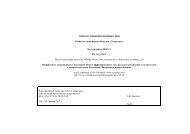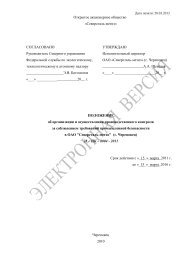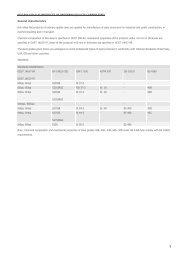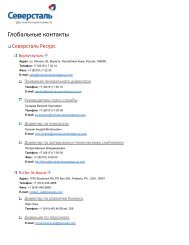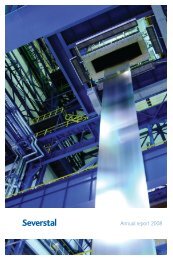Annual Report 2007 - Severstal
Annual Report 2007 - Severstal
Annual Report 2007 - Severstal
You also want an ePaper? Increase the reach of your titles
YUMPU automatically turns print PDFs into web optimized ePapers that Google loves.
Financial statements<br />
OAO <strong>Severstal</strong> and subsidiaries<br />
Notes to the consolidated financial statements<br />
for the year ended December 31, <strong>2007</strong><br />
(Amounts expressed in thousands of US dollars, except as otherwise stated)<br />
l. Income tax<br />
Income tax on the profit for the year comprises current and deferred tax.<br />
Income tax is recognized in the income statement except to the extent that<br />
it relates to items recognized directly in equity, in which case it is recognized<br />
in equity.<br />
Current tax expense is calculated by each entity on the pretax income<br />
determined in accordance with the tax law of the country, in which the<br />
entity is incorporated, using tax rates enacted at the balance sheet date,<br />
and any adjustment to tax payable in respect of previous years.<br />
Deferred tax is calculated using the balance sheet liability method,<br />
providing for temporary differences between the carrying amounts of assets<br />
and liabilities for financial reporting and taxation purposes. The amount<br />
of deferred tax provided is based on the expected manner of realization or<br />
settlement of the carrying amount of assets and liabilities, using tax rates<br />
enacted or substantially enacted at the balance sheet date. Deferred tax<br />
assets are recognized only to the extent that it is probable that future<br />
taxable profits will be available against which these assets can be utilized.<br />
Deferred tax assets are reduced to the extent that it is no longer probable<br />
that the related tax benefit will be realized.<br />
Deferred tax is not recognized in respect of the following:<br />
– investments in subsidiaries where the Group is able to control the timing<br />
of the reversal of the temporary differences and it is probable that the<br />
temporary difference will not reverse in the foreseeable future;<br />
– if it arises from the initial recognition of an asset or liability that affect<br />
neither accounting nor taxable profit,<br />
– initial recognition of goodwill.<br />
m. Provisions<br />
Retirement benefit liability<br />
The Group pays retirement and post-employment medical benefits to<br />
former employees. The calculation of the Group’s net obligation in respect<br />
of defined retirement benefit plans is performed annually by management<br />
using the projected unit credit method. In accordance with this method, the<br />
Group’s net obligation is calculated separately for each defined benefit plan<br />
by estimating the amount of future benefit that employees have earned<br />
in return for their service in the current and prior periods; that benefit is<br />
discounted to its present value and the fair value of any plan assets is<br />
deducted. The discount rate used is the yield at the balance sheet date<br />
on high quality corporate bonds for UK, USA, France and Italy and on<br />
government bonds for Russia that have maturity dates approximating<br />
the terms of the Group’s obligations. Any actuarial gain or loss arising<br />
from the calculation of the retirement benefit obligation is fully recognized<br />
in the current year’s income statement.<br />
Decommissioning liability<br />
The Group has environmental liabilities related to restoration of soil and<br />
other related works, which are due upon the closures of certain of its<br />
production sites. The Group generally estimates provisions related to<br />
environmental issues on a case-by-case basis, taking into account applicable<br />
legal requirements. A best estimate, based on available information, is<br />
calculated, provided that the available information indicates that the loss<br />
is probable. Decommissioning liabilities are estimated using existing<br />
technology, at current prices, and discounted using a real discount rate.<br />
Other provisions<br />
Other provisions are recognized in the balance sheet when the Group has a<br />
legal or constructive obligation as a result of a past event, and it is probable<br />
that an outflow of economic benefits will be required to settle the obligation.<br />
n. Revenue recognition<br />
Revenue is measured at the fair value of the consideration received or<br />
receivable. Revenue is reduced for estimated customer returns, rebates<br />
and other similar allowances.<br />
Sale of goods<br />
Revenue from the sale of goods is recognized in the income statement when<br />
the significant risks and rewards of ownership have been transferred to the<br />
buyer; the Group retains neither continuing managerial involvement to the<br />
degree usually associated with ownership nor effective control over the<br />
goods sold; the amount of revenue can be measured reliably; it is probable<br />
that the economic benefits associated with the transaction will flow to the<br />
entity; and the costs incurred or to be incurred in respect of the transaction<br />
can be measured reliably.<br />
Rendering of services<br />
Revenue from a contract to provide services is recognized by reference to<br />
the stage of completion of the contract.<br />
o. Interest income<br />
Interest income is recognized in the income statement on a time basis,<br />
by reference to the principal outstanding and at the effective interest rate<br />
applicable, which is the rate that exactly discounts estimated future cash<br />
receipts through the expected life of the financial asset to that asset’s net<br />
carrying amount.<br />
p. Interest expense<br />
Interest expense is recognized in the income statement as it accrues,<br />
taking into account the effective yield on the liability.<br />
All interest costs incurred in connection with borrowings, which are<br />
not directly attributable to the acquisition, construction or production<br />
of qualifying assets, are expensed as incurred.<br />
q. Net income from securities operations<br />
Net income from securities operations comprises dividend income (except<br />
for dividends from equity associates), realized and unrealized gains on<br />
financial assets at fair value through profit or loss, realized gains and<br />
impairment losses on available for sale and held to maturity investments.<br />
r. Earnings per share<br />
Earnings per share is calculated by dividing the net profit by the weighted<br />
average number of shares outstanding during the year, assuming that<br />
shares issued in consideration for the companies acquired from the Majority<br />
Shareholder were issued from the moment these companies are included<br />
in these consolidated financial statements.<br />
s. Discontinued operations<br />
Discontinued operations are disclosed when a component of the Group<br />
either has been disposed of during the reporting period, or is classified<br />
as held for sale or other type of disposal at the balance sheet date. This<br />
condition is regarded as met only when the disposal is highly probable<br />
within one year from the date of classification.<br />
The comparative income statement is presented as if the operation<br />
had been discontinued from the beginning of the comparative period.<br />
Assets and liabilities of a disposal group are presented in the balance<br />
sheet separately from other assets and liabilities. Comparative information<br />
related to discontinued operations is not amended in the balance sheet.<br />
82 <strong>Severstal</strong> <strong>Annual</strong> <strong>Report</strong> <strong>2007</strong>





